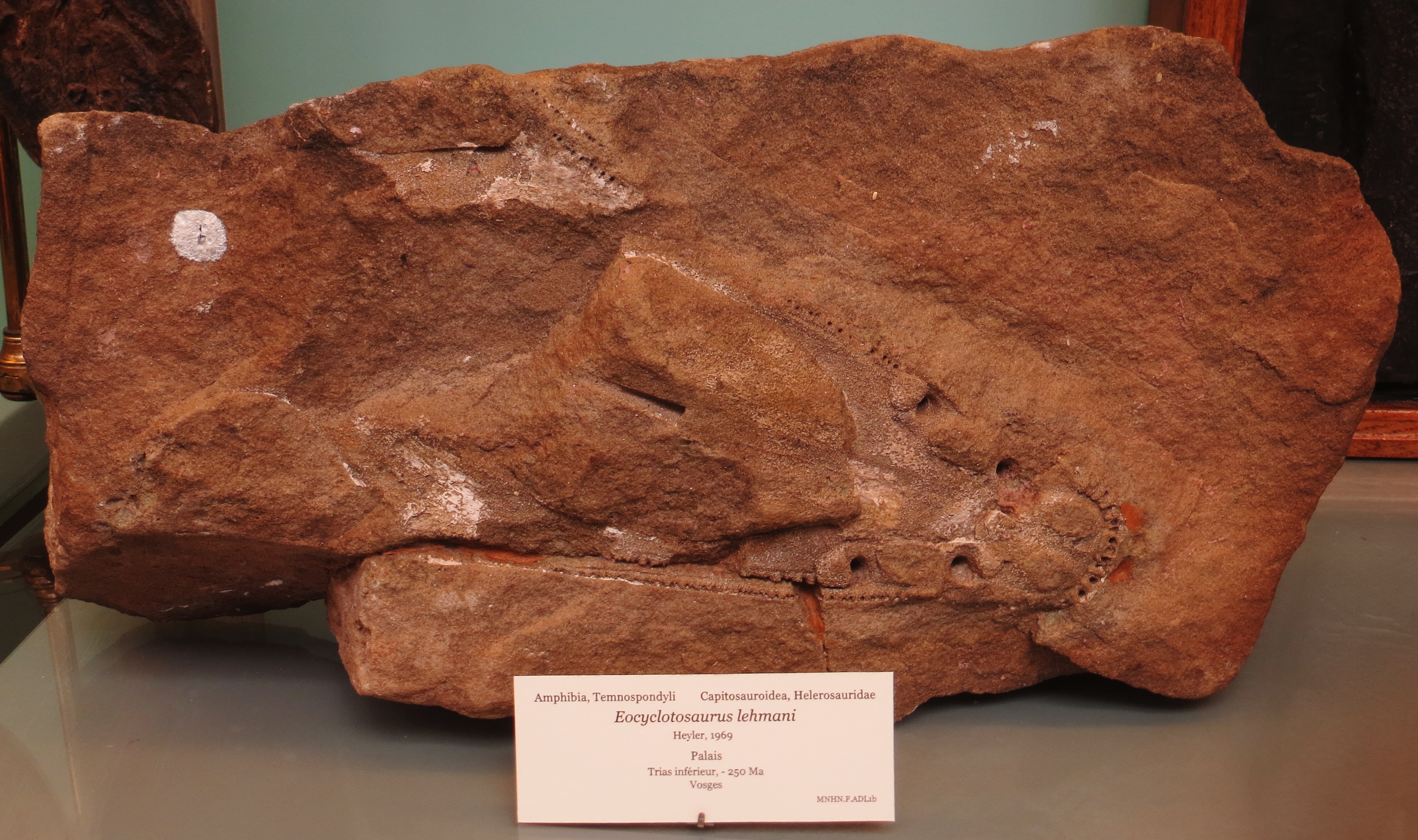Eocyclotosaurus on:
[Wikipedia]
[Google]
[Amazon]
''Eocyclotosaurus'' (Greek ‘èoos’ = dawn, ‘kyklos’ = circle, 'ous' = ear ) is an extinct
 Its habitat was aquatic. Discovered in the 1980s, Northeastern New Mexico has the most abundant bonebed of Eocyclotosaurus.
Its habitat was aquatic. Discovered in the 1980s, Northeastern New Mexico has the most abundant bonebed of Eocyclotosaurus.

genus
Genus (; : genera ) is a taxonomic rank above species and below family (taxonomy), family as used in the biological classification of extant taxon, living and fossil organisms as well as Virus classification#ICTV classification, viruses. In bino ...
of mastodonsauroid temnospondyl
Temnospondyli (from Greek language, Greek τέμνειν, ''temnein'' 'to cut' and σπόνδυλος, ''spondylos'' 'vertebra') or temnospondyls is a diverse ancient order (biology), order of small to giant tetrapods—often considered Labyrinth ...
from the Middle Triassic (Anisian
In the geologic timescale, the Anisian is the lower stage (stratigraphy), stage or earliest geologic age, age of the Middle Triassic series (stratigraphy), series or geologic epoch, epoch and lasted from million years ago until million years ag ...
). The name ''Eocyclotosaurus'' means "dawn round-eared lizard". It is characterized as a capitosauroid with a long and slender snout, closed otic fenestra, and small orbits. It measured over one metre
The metre (or meter in US spelling; symbol: m) is the base unit of length in the International System of Units (SI). Since 2019, the metre has been defined as the length of the path travelled by light in vacuum during a time interval of of ...
and had a 22 cm skull
The skull, or cranium, is typically a bony enclosure around the brain of a vertebrate. In some fish, and amphibians, the skull is of cartilage. The skull is at the head end of the vertebrate.
In the human, the skull comprises two prominent ...
.
It lived between 247 and 242 million years ago in both North America
North America is a continent in the Northern Hemisphere, Northern and Western Hemisphere, Western hemispheres. North America is bordered to the north by the Arctic Ocean, to the east by the Atlantic Ocean, to the southeast by South Ameri ...
, Germany, France and the British Isles
The British Isles are an archipelago in the Atlantic Ocean, North Atlantic Ocean off the north-western coast of continental Europe, consisting of the islands of Great Britain, Ireland, the Isle of Man, the Inner Hebrides, Inner and Outer Hebr ...
during the early Triassic.
Discovery and naming
The genus ''Eocyclotosaurus'' was named by Dieter Ortlam in 1970. Thetype species
In International_Code_of_Zoological_Nomenclature, zoological nomenclature, a type species (''species typica'') is the species name with which the name of a genus or subgenus is considered to be permanently taxonomically associated, i.e., the spe ...
is ''Eocyclotosaurus woschmidti'', the specific name honouring Wolfgang Schmidt.
Description
Compered to '' Cyclotosaurus'', ''Eocyclotosaurus'' has a similar morphology in postorbital division of the skull. However, in ''Eocyclotosaurus'' the depth of the occiput is greater.Skull
The species is narrow-headed. Orbits were smaller in ''Eocyclotosaurus'' and related forms compared to other taxa such as ''Mastodonsaurus
''Mastodonsaurus'' (meaning "teat tooth lizard") is an extinct genus of temnospondyl amphibian from the Middle Triassic of Europe. It belongs to a Triassic group of temnospondyls called Capitosauria, characterized by their large body size, large ...
'' who had up to three times the size of smaller eyed taxa. Posteromedial expansion is absent in ''Eocyclotosaurus'', due to anterior snout
A snout is the protruding portion of an animal's face, consisting of its nose, mouth, and jaw. In many animals, the structure is called a muzzle, Rostrum (anatomy), rostrum, beak or proboscis. The wet furless surface around the nostrils of the n ...
region being narrower. Premaxillary teeth are transversely elongated. The jaw is heavily reticulated and has a ridge and groove ornamentation of the angular.
Unambiguous autapomorhies
The tabular horn is situated on the side and toward the back of the body / laterally directed and suturing with the squamosal posteriorly. The paraspenoid cultriform process is expanded at the base and constricted at midlength. The upper jaw condyle does not join with the quadratojugal. The vomerine plate lies anterior to the interpterygoid vacuities and is elongate. The parasphenoid cultriform process is deep and thin ventrally. The parasphenoid cultriform process is underplated by posterior extension of the vomer.Phylogeny
The phylogenetic position of the genus ''Eocyclotosaurus'' within the capitosaur taxa according to Witzmann et al. (2016)Paleobiology
The skull of ''Eocyclotosaurus'' was more suited for capturing small prey compared to ''Cyclotosaurus'' who was tested to have more capabilities to hunt larger prey. Feeding mechanism and diet: It has been analyzed to capture small prey using a side striking behavior. General scenarios for eating heavier for temnospondyls are inferred based on their atomical evidence. Prey would be captured in their teeth, manipulated into swallowing position by their tongue, and swallowed with the assistance of their tongue. The reduction of the cross section of its skull and the elongation of its nasal bones was an adaptation to reduce drag during lateral movement of the head, increasing the efficiency of aquatic feeding.Paleoecology
 Its habitat was aquatic. Discovered in the 1980s, Northeastern New Mexico has the most abundant bonebed of Eocyclotosaurus.
Its habitat was aquatic. Discovered in the 1980s, Northeastern New Mexico has the most abundant bonebed of Eocyclotosaurus.
Stratigraphic and geographic range
By the early Anison, most major crown clades were present: heylerosaurids (''Eocyclotosaurus''), mastodonsaurids, stenotosaurids. The origin of the genus ''Eocyclotosaurus'' was at the Spanthaian andAnisian
In the geologic timescale, the Anisian is the lower stage (stratigraphy), stage or earliest geologic age, age of the Middle Triassic series (stratigraphy), series or geologic epoch, epoch and lasted from million years ago until million years ag ...
boundary, separate from ''Cyclotosaurus'' in the late Ladiunian. Separate evolution suggest separate stratigraphy.
Images
References
{{Taxonbar, from=Q5381642 Capitosauria Triassic temnospondyls of Europe Triassic temnospondyls of North America Fossil taxa described in 1970 Anisian genera